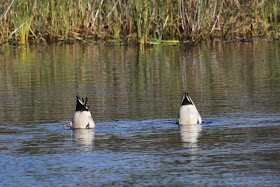The dabbling ducks (
Genus Anas) are inhabitants of marshes, ponds, and small lakes. These habitats often are thick and tangled. When danger comes, they have to get up and out quickly. They leap into the air - virtually straight up - and then get going.
Taking flight in this manner is very different from almost all other other waterfowl, which need a running start - often a very long running start.
When any of these birds take flight, it happens so fast that we can easily miss the details. My photography is a relatively new addition to my birding (about 6 years - less than 3 with good equipment). Freezing the moment with the camera has allowed me to see the detail and to learn - plus, it's fun!
This first photograph captures dabbling ducks as they "leap" into flight. In subsequent posts, I will have details from a burst of photos. This is the first in that burst.
 |
| Mallard (drake) and 3 Northern Pintails (females) "leap" from the water's surface |
In the next photo, a Gadwall is in the air, while American Coots are just beginning to "run" on the water's surface in order to gather enough speed to get airborne.
 |
| A Gadwall "leaps" into flight while American Coots "run" to take flight |
The mixed flock of Green-winged Teal and Northern Pintail are on the wing. The American Coot (lower left) is still running, not quite airborne. Note the splashes from the coot's feet.
 |
| Green-winged Teal and Northern Pintail - American Coot lower left |
To illustrate the contrast with the dabblers, next are two photographs of mergansers. Mergansers are adept divers with legs located toward the rear of the body to assist as they swim underwater; this also makes them very awkward on land. When taking off, they need room to run ...
 |
| Common Mergansers (hens) |
 |
| Hood Merganser (hen) |
Where dabblers leap into the air, American Coots patter across the water, flapping furiously in the effort to get airborne. They are tough, adaptable, and common - and thoroughly entertaining. Watching them take flight, or watching them doing whatever they may be doing, will explain the origin of such phrases as - "He is crazy as a coot." - or - "He's a crazy old coot." (This last saying is one I am beginning to find offensive.)
 |
| American Coot |
More on dabblers leaping into the air in a few days.
Good Birding!


















































